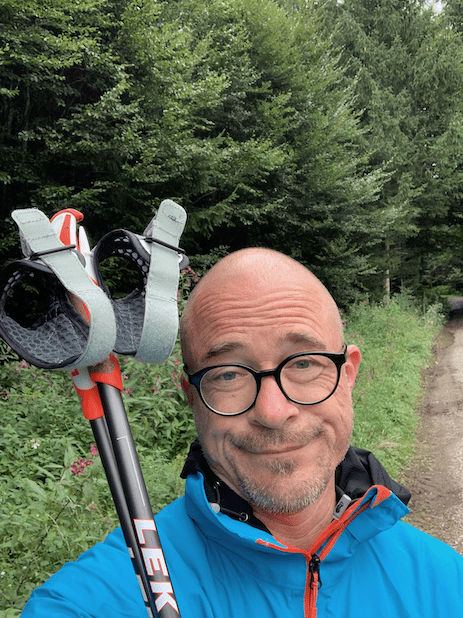I’ve been Nordic walking regularly for a few weeks now.
Is that cool? No.
Is it something to show off at parties? Nope.
And what it has to do with learning? Well…
It all started with pain. For months I was suffering from headaches, several times a week and often for several days.
The doctor could not find anything except extremely tense muscles in my neck and shoulders. These tensions triggered the headaches. Magnesium and sometimes painkillers helped a little, but I wanted to get to the bottom of the causes.
My doctor offered me to spend two weeks in a clinic for intensive pain therapy. There I could work on the causes of the pain and eliminate them with the help of new exercises: Relaxation techniques such as meditation or progressive muscle relaxation, physical exercises, muscle building, movement exercises and much more.
In total, I participated in about 45 sessions over 16 days. One of them was Nordic walking. At first I was hesitant. Nordic Walking was in my eyes something for older people (I am 50 years old, but older are always the others), pensioners with a lot of time, who want to do something for their health. Not bad, but nothing I could identify with either. After all, I’m a jogger, cyclist and even used to box for years.
So now Nordic walking on the clinic grounds, along with other pain patients.
Even after the first hour, I noticed that it felt good. My shoulders and neck relaxed, the pain disappeared, and I was loose and flexible.
The experience repeated itself several times.
What happened when I got back home? I did my exercises, meditated again, and felt better. But after about two weeks, I woke up in the morning with a headache again. I remembered the good feeling after Nordic walking, took my poles and started walking.
After an hour the pain was gone. I also had this experience several times.
Soon walking became a routine, today I go walking 4-5 times a week. Not only when I have pain, but also because it simply feels good: taking a break, breathing fresh air, moving.
And what does that have to do with learning?
If someone had explained to me that Nordic walking is healthy, I would have agreed – but I wouldn’t have done it. Understanding something cognitively doesn’t trigger behavior change, does it?
It needed the pain as a trigger. And – more importantly – the experience. I physically experienced that it was good for me. And I had that experience several times.
In designing our workshops and trainings, we wrestle with just that: finding the pain (challenges, problems, conflicts) and allowing leaders to have a new experience.
Explaining something is not enough. Only the positive experience can trigger a change in behavior. The gain (pain disappears, relaxation and agility increases) from the change must be greater than the effort (taking time, going out, enduring bad weather).
And another realization: I could have had this good feeling much earlier. Standing in my way was the image and judgment I made of Nordic Walking (for old people, boring, not cool).
How often do prejudices or a perceived bad image keep us from significant change and development?
How often do we NOT change something for fear of making fools of ourselves?
If change is about experience, then we must repeatedly let go of the familiar (and often painful) world. We must consciously expose ourselves to new experiences. And we must only judge them afterwards.
This is my learning process:
Pain – new experience – sustainable change
